Podcast: Download (Duration: 57:43 — 56.6MB)
Get Notified Of Future Episodes Apple Podcasts | Spotify | Amazon Music | Android | Blubrry | Gaana | TuneIn | Deezer | Anghami | RSS | More
Colin is a master at selling from stage. That’s why James has invited him to share how to make a webinar presentation, using stories to power sales.
In their chat, you’ll hear what the hero’s journey is and is not in a product sales presentation.
You’ll discover what qualities to balance in emotional storytelling.
And Colin will let you in on his four-step format for a sales presentation.
Table of contents
1. The gift Colin didn’t know he had
2. Can businesses still benefit from doing webinars?
3. The hero’s journey – how NOT to do it
4. From origin to conversion story
5. How one speaking gig changed everything
6. Balancing vulnerability with credibility
7. When you haven’t got the rock bottom narrative
8. Three levels of certainty around your offer
9. The right customers are your best validation
10. The presentation-building process
-
a. Touch their hearts from the start
b. How do you shift people’s minds?
c. Now equip their hands
d. Finally, move their feet
11. Why you don’t want people picking your brain
12. Some parting advice
The gift Colin didn’t know he had
Colin had always been obsessed with speaking, and he used to teach productivity.
Then one day in a mastermind, an attendee came up to him and said, Colin, I don’t want to learn how to be more productive from you. I want to learn how to sell from stage from you – the way you speak and communicate, I want to learn that.
That was four and a half years ago. And it started Colin’s journey of teaching people how to speak and sell from stage, first actual, then also the virtual stage.
Can businesses still benefit from doing webinars?
The big question James has for Colin now is, are webinars still useful in 2022?
For Colin, a webinar is a really nice entry point for people to connect with audience in a leveraged way. And he thinks webinars can change and evolve.
It doesn’t have to be the classic sales presentation where you’re doing slides, and presenting ideas, never engaging with the audience, and then trying to pitch at the end.
A webinar could be a mastermind-style session where you’re in a Zoom meeting and you’re actually seeing people’s faces.
There are many different mechanisms you can use, but for Colin a webinar presentation is cheap and easy to set up, and it’s a great way to just build rapport with people fairly quickly.
You can make an offer, usually sub $2,000 in an hour, and if people are the right fit and they resonate with you, you can get them to join a program under $2,000. If it’s over 2000, it usually take a call or the like, in Colin’s experience.
The hero’s journey – how NOT to do it
Now, Colin is famous for using stories to sell, and James would like to ask about a piece of content.
He saw Colin on Instagram talking about the wrong and right way to do a webinar, in particular the wrong and right way to approach the hero’s journey.
At JamesSchramko.com/storyformula, you’ll find training from Colin about using stories to convert. But James would like him to talk a little about the right and wrong way of going about it.
It’s a fairly new revelation to Colin. And that is that most people think, at the beginning of a presentation, that they should tell their story.
This is their origin story – where they’re from, how many kids they’ve got, maybe where they went to college, or didn’t go to college. It’s a story only their mom would really be interested in.
From origin to conversion story
The trouble is, the origin story is about you, and what you want is a conversion story, about the people you’re talking to. When you design your story, you need to have in mind, I’m not telling my story. I’m telling the audience’s journey of their story.
If you tell it in the right way, the audience will hear your story. But then they’ll start making unconscious connections in their mind of, that’s how I felt as well – I’ve been through similar stuff; that person’s exactly like me.
There are three questions, says Colin, that you have to answer with your conversion story:
1. Are you like me? How do you tell your story so that people relate to you on some level?
2. Can they lead me? Share your story in a way that shows you’ve gotten results or breakthroughs.
3. Is there a path I can follow? This is where you build your story around a transformational experience that you had, that epitomizes the pathway that you can help people with.
How one speaking gig changed everything
Colin now gets to tell his story.
Colin, then a life coach, was sitting at his desk in southern Sydney. It was an old brown desk from a 99 cent store, with missing legs and phone books propping it up.
At the time Colin had what you might call half a client – a guy he would coach every other month, and who would pay him every other month. Colin had a big desire to make a difference, but no idea how to get other clients.
His landline rang. It was a friend who had a speaking engagement he couldn’t do – did Colin want it?
Colin took it. It was his first free speaking engagement.
He remembers being nervous, and becoming even more nervous at the venue, when the event organizer told him there’d be 137 people, the biggest attendance they’d had.
That evening, Colin spoke, and made an offer at the end. Out of 137 people, 125 gave him their personal details to follow up, and he ultimately signed up 12 full-time coaching clients.
Three days later, the director of HP, who’d seen Colin speak, engaged him to talk at their next global training day. There were five and a half thousand people, and it was Colin’s first paid speaking event.
In one presentation, Colin’s entire life changed. And it’s evolved from there.
Balancing vulnerability with credibility
James liked the story, though the phone books and the landline do date Colin.
True, says Colin. But for stories to work, you have to get the balance right of credibility and vulnerability to create a magnetism and attractability in your story.
One of James’s previous guests, Chris Haddad, is known as an emotional storytelling copywriter. And he said you should tell the stories that absolutely petrify you to tell – that’s how vulnerable you can get.
James appreciates that point of view, but there are some traumas he believes one shouldn’t keep bringing back into their life.
And the story of the guy who was previously bankrupt or in prison or who crashed four companies and now has the answer doesn’t appeal to James. It’s not something he wants to put in front of his audience.
Colin agrees – some people just become drama on stage.
When you haven’t got the rock bottom narrative
And when that happens, says James, he can’t relate. He might have been a bit challenged at some points in his life, but he was never bankrupt or jailed on his way to success.
And you don’t have to be, to have a story, says Colin. In his case, his story was, he was new, just starting out.
James can relate to that. He actually placed himself in the story while Colin was telling it.
And that is the purpose of a conversion story, says Colin.
Three levels of certainty around your offer
James got an email recently from someone wanting a coach. They’d just come into the market, helping people with lead gen, traffic and conversions, but they had no traffic conversions or customers and wanted a coach to help them.
Well, hang on a minute, said James. Have you tried your specialty on yourself?
Some people just aren’t ready to put themselves out for their offer, he says.
Colin agrees. For him, there’s three levels one has to meet before putting out an offer:
1. They’ve had a personal transformation. In other words, they’ve been through their own process, and they’ve got a result.
2. They’ve actually spent the time to have process proof. That means they’re clear on their process, they’re clear on the structure, they’ve taken what they’ve gone through and built unconsciously, and made it extremely conscious and clear. So at least they know how to talk about what they do, as opposed to just, I’ve been through it, and it’s awesome.
3. They have social proof. Is it actually replicable and scalable with other people? And are they getting a statistically sound level of results with the group of people that they’re seeing?
When you put the three together, that’s when you start to get offer certainty. And then you just keep building that as you go through the years.
The right customers are your best validation
James loves it.
He also thinks one of the litmus tests for a product or service is somewhere in the sales process – if they could say, Listen, speak to some of my customers about how I’ve been helping them and whatever they say, I’ll go by that.
He’ll be happy to be judged by that, not by his impression of how well he thinks he’s helping people, but by what they say. Because if you can generate that, then you’re good enough to go to market and be bold with it, for sure.
Colin has to say, it’s taken years for him to really feel confident and congruent with asking people to invest in themselves.
When Colin’s presenting an offer, it’s not him asking for money. An offer is him asking the audience if they align with what the offer will create.
It’s asking people to enter a place of full commitment to themselves. And the money is just one of the currencies of that commitment.
There’s many currencies – money, time, effort, confidentiality, energy, intention – so many currencies in the offer. But when people enter that offer, Colin protects the offer.
He’s saying, If you’re after this outcome, I’ve created this space for you. And to enter this space, there is commitment that’s required, and that is money, time, effort, confidentiality, all those things – do you want to enter?
The presentation-building process
Now this will be the most helpful part, hopefully, says James, though everything up to now has been really good.
You’ve got an established product, you’re good at what you do, you’ve got prospects committed to hear you on a live product sales presentation online. What is the process to build that presentation?
Do we have four hours, asks Colin?
What four percent of things must absolutely be there, asks James?
You start with the offer, says Colin. The offer is the outcome – so you always start with the offer and you build back.
It could at least be a next step of, Hey, do you want to book a phone call? Do you want to do a strategy session?
It doesn’t have to be a direct, what Colin will call a sharp sell. So there’s three types of presentations – there’s a sharp sell, which is direct to offer, there is a soft sell, which is like a book a call or a download a PDF, and then there’s a no sell, which is a classic keynote.
Then, for Colin, there’s four big elements of every presentation.
1. How do I touch their hearts right at the start? Your story is a big part of it, if it’s done really well. There’s also this idea of, how do you show them that what you’re about to talk about is really relevant and important right now? Not nice to know, necessary to know right now. And really, that you understand the audience.
Most people get a presentation wrong because they think that it’s about them presenting content. But it’s first of all showing to the audience that you get them, that with integrity, you deeply understand them.
2. How do you shift people’s minds? The second part is shifting their minds. What most people do is try to teach. But the goal of the presentation is to actually prepare people to commit to themselves.
And so it’s not about just teaching content. Sure, you should teach them helpful content, absolutely. But you have to keep in mind this idea of shifting the beliefs and the resistances that people have to commit to themselves and commit to the next level, in order for them to actually say yes to the offer. And that’s actually valuable in itself.
3. Now equip their hands. After shifting people’s minds, you need to equip them. This is something you’ve got to be careful with. Most people do too much equipping of hands, and they actually lose the sale.
And it actually does the listener a disservice, because if you give them too many things to do, they’re not going to do them anyway, because they’re not committed. What Colin recommends is you teach content that creates decisions.
4. Finally, move their feet. The final step is moving their feet. And that is the pitch. That’s transitioning to the pitch and actually making the offer, whether it’s a direct sell, or whether it’s a next step, book a call or the like.
That’s the general overarching flow that Colin goes through.
Why you don’t want people picking your brain
James has a specific question. He told a client he’d ask this.
This client gives away a treasure trove of stuff, and runs traffic to it. Then he has a lot of trouble on the back end trying to sell people into the membership.
James is curious what Colin thinks of that, given the equip their hands thing.
It’s like picking the brain, says Colin.
Someone comes to you and says, Can I pick your brain? They spend two hours with you, you buy the coffee.
Two months later, you catch up with them – Oh, how’d you go with the stuff I gave you? They’re like, Oh, I just haven’t had a chance to do anything yet.
James is a generous person, but he stopped that sort of free consult one day when he missed his surf.
Now, he’s more likely to ask what exactly someone would want answered if they did go for coffee. He answers it on the spot and they’re done.
Some parting advice
What advice would Colin have for someone who’s listened this far?
Stop picking people’s brains.
And just commit to yourself on the next level. Colin knows, for himself, anything that’s happened in his life has always been through a courageous decision.
There’s probably something you’ve been thinking about that you’re scared of doing. And when it comes down to it, being an entrepreneur is being willing to back yourself.
Whether that’s working out your core story so you can share it on Facebook Live, or whatever that next scary thing is, Colin thinks that’s usually the path forward. So that’s his encouragement for listeners.
Access a trove of business resources and support inside the James Schramko membership
Liked the show? Enjoy all the episodes when you subscribe on iTunes
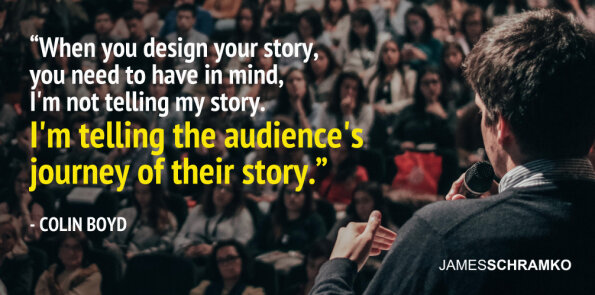
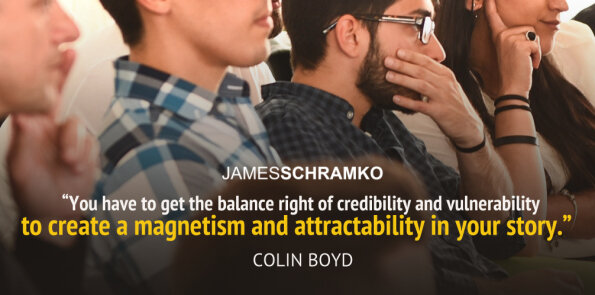
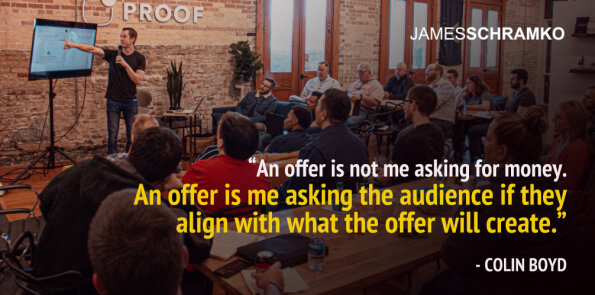
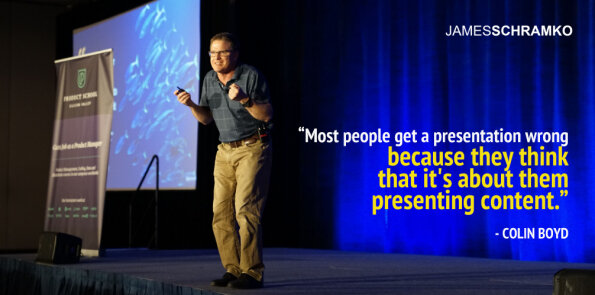

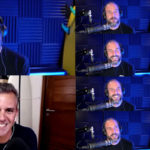







Leave a Reply